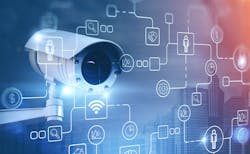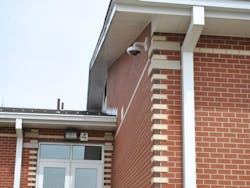How to Unleash the Potential of Advanced Video Surveillance Solutions
Today’s advanced video solutions offer campuses much more than live video. The options for modern video surveillance technology and its customizability are well-suited for unique campus environments with evolving needs.
One important shift that campuses are making with video surveillance is incorporating audio and video together so that security stakeholders have both eyes and ears on the environment. Two-way audio capabilities can be particularly useful in campus environments in a number of scenarios. IP audio integrated with video can be tailored to target specific pain points. In one example, a large healthcare campus needed to stop staff from going into emergency exit stairwells in non-emergencies. Instead of blindly responding to access control swipes, management solved the issue with a video motion detection analytic that was triggered if a person walked past a certain threshold in the stairwell, while integrated audio initiated an automatic warning message.For campus environments that use video surveillance as a primary deterrent, public view monitors serve as useful tools in public areas or for unique applications. Some organizations use facial detection analytics tied to the video that allows the public view monitors to change channels or turn on to a specific camera when a face is detected. In one particular use case, a healthcare campus had a long hallway with a near 90-degree turn for which some staff members were nervous to use late at night. A public view monitor placed at the corner of the hall allowed staff to see what was ahead while adding a feeling of safety knowing any interactions would be recorded.
Another integration that provides an enhanced level of safety and security for staff is duress and emergency notification systems tied to video. Wearable or stationary duress technology can be integrated with surveillance to provide an elevated level of situational awareness. For tornadoes, weather emergencies or other incidents, speakers can manually or automatically give staff and visitors instructions on what to do and where to go.
Body cameras are also gaining attention in campus environments. Many campuses have implemented, or are piloting, body cameras for public-facing positions such as security officers and parking attendants. Technology allows campuses to document incidents, while simultaneously serving as a deterrent for devious behavior. In some campus settings, security stakeholders report reduced complaints against staff when a record of interaction exists. When a contradiction does exist, staff can feel supported knowing there is evidence of the event.
The Boost of Analytics
In addition to system integrations, campuses with modern video surveillance technology can garner a significant amount of value from the strategic use of analytics. The advancement of technology and available analytics force-multiplies the capability of video surveillance, as well as streamlines intelligence, response and investigations. Many cameras come with built-in analytics ready for use and, with open platform devices and technology, the ability to add, expand and customize further analytics for about any scenario is also within reach.
Video analytics that proves useful for campus settings include:
● People counting. In campus settings, people counting can be used for reporting purposes to see how often particular buildings or entrances are used, as well as to determine where staffing is needed. With edge analytics – meaning cameras with analytic processing capabilities built into the camera itself – cameras can even track and send metadata to stakeholders for custom scenarios, such as the number of people in the lobby throughout the day or how many people occupied the handicapped parking spots near the entrance.
● Loitering detection. Loitering detection can detect incidents on the perimeter or detect a person waiting outside a highly secure area, for example. Security personnel can get alerts to take a look at the situation and determine the appropriate response. IP audio can be integrated to broadcast automatic audio messages asking people to leave the area.
● Object Detection. Object detection can be customized on particular cameras or buildings on campus for a number of scenarios, such as to target areas where packages get delivered or public areas where personal items may be left. Object detection can be customized to identify specific objects like people, vehicles, or even conditions such as a large bag left unattended for a threshold of time.
● Facial recognition and license plate recognition. While face detection can also be used to allow cameras to identify that a face is present, facial recognition can be applied to match against enrolled employees or to match faces against a banned list or federal database. Similarly, license plate recognition (LPR) applications can be used in parking garages to read license plates against authorized or prohibited vehicle lists.
● Cross Detection. Cross-detection is more of an integrated application than just an analytic. By integrating access control with video and motion detection, for example, campus stakeholders can receive more meaningful event notifications along with additional situational awareness. In a restricted or unattended area, security personnel may want to know not only when a particular door is opened, but whether the person actually walks through the door or crosses a given space threshold. This provides added eyes to an access control event that can give responders much-needed context when reviewing an incident.
● Situational analytics. Analytics can be programmed to recognize patterns to enhance the safety of a campus environment, as well as simplify how and where staff spend their time and efforts. Crowd detection can alert security personnel when groups of people are congregating inside or outside a building. Other situational analytics, such as a person running or falling off a bed, will send alerts to staff if a person is otherwise acting outside the chosen normal behavior for that environment.
● Streamlined search. While many analytics can be used to increase situational awareness and help stakeholders create a proactive security posture, campus locations may not have staff responding to incidents around the clock or may primarily use video surveillance for investigations and response after an incident has occurred. Forensic analysis of video from extensive camera deployments can be tedious and extremely difficult to find that proverbial needle in a haystack. In these cases, the benefits of search analytics can’t be overstated. Analytics can streamline searches based on date, timestamp and other characteristics, narrowing down thousands of hours of video or hundreds of cameras to a manageable size of data for staff thereby accelerating investigations and improving results.
● Advanced analytics. Advanced analytics can be customized for unique applications. For example, acoustical analytics can be tied with video to detect a multitude of behaviors more accurately such as aggression or shouting, gunshots or even car alarms. On the perimeter, video surveillance can be equipped with geo-fencing analytics to trigger trespassing or loitering at particular locations. If triggered, automatic audio can alert the offenders to get off the property or tell them that a response is imminent.Building a Framework to Protect Data and Enhance Security
Video can serve as a powerful deterrent, while also being an intelligent voice for the organization, keeping the campus safe and offering situational awareness to achieve both a proactive security posture and an informed response. In order to protect those investments and use the technology to its fullest potential, however, campus stakeholders must make several considerations before implementation.
- Primarily, campus security stakeholders must recognize the capabilities of their technologies. Understanding the requirements of advanced solutions is a big piece to setting a realistic budget and meeting the expectations of security staff, management, employees and other affected parties. For example, some analytics such as facial recognition take up larger bandwidth than others and maybe more viable on-prem using high-end graphic processing units (GPUs) on the server versus as an edge solution. Understanding these requirements involves research, piloting or demonstrations, and trusted product and service providers that will take the time to answer questions, no matter how small.
- Before any installations take place, it’s a good idea for organizations to conduct a security audit. Security audits will help determine the organization’s needs but, most importantly, dictate what technology will meet those needs without overspending. For example, there are many scenarios where particular types of cameras or strategically placed installations can meet an organization’s needs with fewer devices.
- Choosing a centralized video management system (VMS) is one of the most important considerations an organization can make. The VMS is the heart of a video surveillance and analytics program, tying together all the other technology and devices in the organization in one place, and even allowing for remote access. By having a single platform, campus stakeholders can make use of multiple data streams coming through to boost situational awareness, use for reporting and efficiency purposes, and allow the organization to conduct thorough investigations.
4. Once security technology has been deployed, campuses must protect the investment and all that data with strong cybersecurity practices. Campus stakeholders should be versed on what cybersecurity capabilities their technology has built-in. Video cameras and devices on the network should be built with zero trust in mind. Access to video and data should be protected by multi-factor authentication. Management should also take care to ensure that privileged access is only given to those who need it and regularly review who has that access. Firmware updates and system upgrades should be scheduled, checked and performed regularly. Lastly, campuses should look for vendors that provide quality technical support, particularly for organizations that don’t have an in-house department to help with issues or upgrades.
The Path to Success
Though campus security needs can be extremely diverse, advanced video solutions offer the capabilities and customization to deliver both short-term and long-term value to any organization. The key to having a successful, robust video surveillance program on any campus, however, goes beyond just determining technological capabilities and requires campus security stakeholders to define their present and future requirements, building infrastructure with flexibility and possibility in mind. Advanced video solutions can be the eyes and ears of any campus, but in order to continue meeting the organization’s needs into the future, thoughtful and flexible installations are now imperative.
About the author: Paul Baratta is the Manager of Industry Segment Development for Axis Communications.



